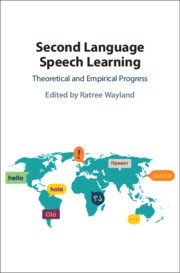Book contents
- Second Language Speech Learning
- Second Language Speech Learning
- Copyright page
- Dedication
- Contents
- Figures
- Tables
- Contributors
- Preface
- Acknowledgments
- Part I Theoretical Progress
- Chapter 1 The Revised Speech Learning Model (SLM-r)
- Chapter 2 The Revised Speech Learning Model (SLM-r) Applied
- Chapter 3 New Methods for Second Language (L2) Speech Research
- Chapter 4 Phonetic and Phonological Influences on the Discrimination of Non-native Phones
- Chapter 5 The Past, Present, and Future of Lexical Stress in Second Language Speech Production and Perception
- Part II Segmental Acquisition
- Part III Acquiring Suprasegmental Features
- Part IV Accentedness and Acoustic Features
- Part V Cognitive and Psychological Variables
- Index
- References
Chapter 4 - Phonetic and Phonological Influences on the Discrimination of Non-native Phones
from Part I - Theoretical Progress
Published online by Cambridge University Press: 21 January 2021
- Second Language Speech Learning
- Second Language Speech Learning
- Copyright page
- Dedication
- Contents
- Figures
- Tables
- Contributors
- Preface
- Acknowledgments
- Part I Theoretical Progress
- Chapter 1 The Revised Speech Learning Model (SLM-r)
- Chapter 2 The Revised Speech Learning Model (SLM-r) Applied
- Chapter 3 New Methods for Second Language (L2) Speech Research
- Chapter 4 Phonetic and Phonological Influences on the Discrimination of Non-native Phones
- Chapter 5 The Past, Present, and Future of Lexical Stress in Second Language Speech Production and Perception
- Part II Segmental Acquisition
- Part III Acquiring Suprasegmental Features
- Part IV Accentedness and Acoustic Features
- Part V Cognitive and Psychological Variables
- Index
- References
Summary
Two non-native phones can be discriminated well if each one is perceived as a different native phonological category. In that case, the perceiver’s prior attunement to a phonological distinction in the native language supports discrimination in the non-native language. Discrimination of non-native phones is more challenging when both are perceived as similar to the same native phonological category, but a perceived difference in phonetic goodness-of-fit to the native category can nevertheless support discrimination. There are four different sources of information that a perceiver might use to discriminate contrasting non-native phones: 1) sensitivity to a native phonological contrast; 2) sensitivity to the phonetic goodness-of-fit to a native phonological category; 3) language-independent phonetic distance, and; 4) perceptual salience of a non-linguistic auditory difference. Using the Perceptual Assimilation Model (Best, 1995) as an example, the aim of this paper is to outline how a theoretical model of cross-language speech perception might account for these sources of information. On the basis of that review an evaluation will be made of the methodological requirements for determining which sources of information listeners use for discrimination.
Keywords
- Type
- Chapter
- Information
- Second Language Speech LearningTheoretical and Empirical Progress, pp. 157 - 174Publisher: Cambridge University PressPrint publication year: 2021
References
- 3
- Cited by



